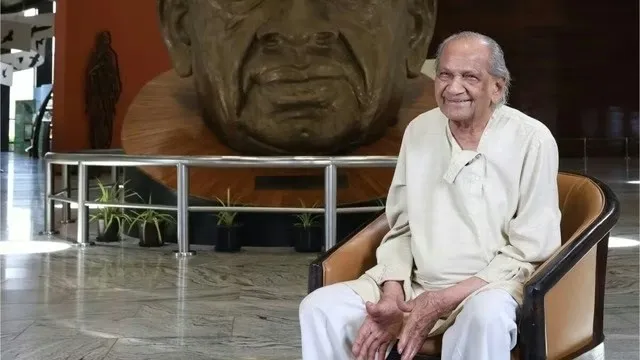Lucknow: Where does happiness come from? IKS points out that our sense organs –eyes, ears, nose, tongue, and skin, are gateways that allow us to experience the world and derive pleasure. For example, tasting favourite food or hearing good music brings happiness because our senses are engaged in the experience. However, we need to use our motor organs to manage the environment and create situations that bring joy. Happiness is an internal state of being, caused by experiencing the world through our senses.
The Sastras speak of several levels of happiness. The stillness of sleep is not actively known, yet we feel deeply refreshed and joyful upon waking up. This indicates that happiness can also arise from a state of inner peace, even when disconnected from the outer world.
The ancient ṛṣis (sages) of Bhārat found that happiness, the ultimate pursuit of human life, was not dependent solely on external circumstances. They uncovered a vast reservoir of joy within themselves—a treasure that transcended the usual states of waking, dreaming, and even deep sleep. This fourth state is known as Turīya—a state of pure bliss also known as Ātma-sukha.
In the Indian framework, there are three primary types of happiness:
- Indriya-sukha (Sensory happiness): This is the pleasure we obtain by interacting with the world through our sense organs, indriyas. Whether it’s enjoying a delicious meal, listening to music, or recalling a pleasant event, the mind and intellect (Manas and Buddhi) play a role in perceiving and processing these experiences. Though they provide temporary satisfaction, these pleasures are always externally driven.
- Svāpna-sukha (Bliss in the dream state): This refers to the happiness experienced in dreams, where the mind creates a world of its own, independent of external sensory input. In this state, the impressions stored in the subconscious mind (Vāsanās) manifest, giving rise to experiences of pleasure, fear, or joy. While dreams can offer moments of bliss, this state remains fleeting and illusory, as it is not grounded in physical reality.
- Nidrā–sukha (Happiness of Sleep): The happiness we experience in deep sleep is different. Here, we are completely cut off from the external world, and although we are unaware of the joy while asleep, we feel refreshed and restored upon waking. This state represents a form of happiness detached from sensory input, but it lacks awareness during the experience.
- Ātma-sukha(The joy of the Self): A profound contribution of the Indian tradition is the discovery of Turīya—a state where one is both detached from the world (like in deep sleep) and yet fully aware (like in waking life). This state of consciousness transcends the limitations of sense organs, the mind, and intellect, allowing the individual to tap into the ever-present joy within. Since this state is independent of external stimuli and is intrinsic to one’s true nature, it is called Ātma-sukha—the happiness of the Self.
The Taittiriya Upanishad illustrates the different levels of our existence with a story in the Brighuvalli.Bhrigu went to his father Varuna to learn the secrets of the cosmos and aboutĀtman. Varuna directedhim to practice tapas and ponder over the issue. After a great deal of contemplation,Bhrigu understood that the body that is maintained by the food we eat forms the person, the ātman. This is the annamayakoshaor the corporeal sheath. Whenhe reported this to Varuna, he was advised to contemplate the issue further. Aftera lot more thinking, Bhrigu realized that there was more to a living person thanthe gross body. A living person is not just the gross body, but a living, breathingperson. Thus he realized thatātmanwas prāna, the life breath. When he reportedthis to Varuna, the latter suggested that he think about it further.
When Bhrigu thought a lot more about the issue, he realized that a living person isnot just one who eats and breathes; he feels many emotions and reacts to the worldaround him. This is the level of the mind, Manas. Thus he realized that ātmanwas manomaya. When Varuna again suggested that he ponder further, Bhrigurealized that even the Manasis not always stable or having the right knowledge.

It is fickle and prone to mistaken notions. What is more reliable is the knowledge
of the Buddhi, the intellect. Thus he realized that ātmanis vijnānamaya, thesheath of knowledge.Nexthe realized that there is a level even higher than this, which even thesheath of knowledge, the vijnānamaya koshadoes not touch – and that is the levelof bliss, ānanda. The ānandamayastage is the highest level of existence andclosest to the pure state ofātman. The state of bliss attained in Brahma-jnānaand is akin to the aesthetic enjoyment, Rasaexperience in the arts. Thus in theunderstanding the levels of the Pancha koshas, we understand a living person andātmanmore deeply with each step.
Education should aim at creating environments that promote such deep, reflective learning. In the IKS view, joy or Ānanda and knowledge or Jñāna are closely connected and should be pursued together. Knowledge, when pursued beyond mere intellectual understanding, becomes a path to self-realization and eternal happiness, where each step in the acquisition of knowledge brings us closer to the inner joy that resides within.
Team Siddhanta Knowledge Foundation





